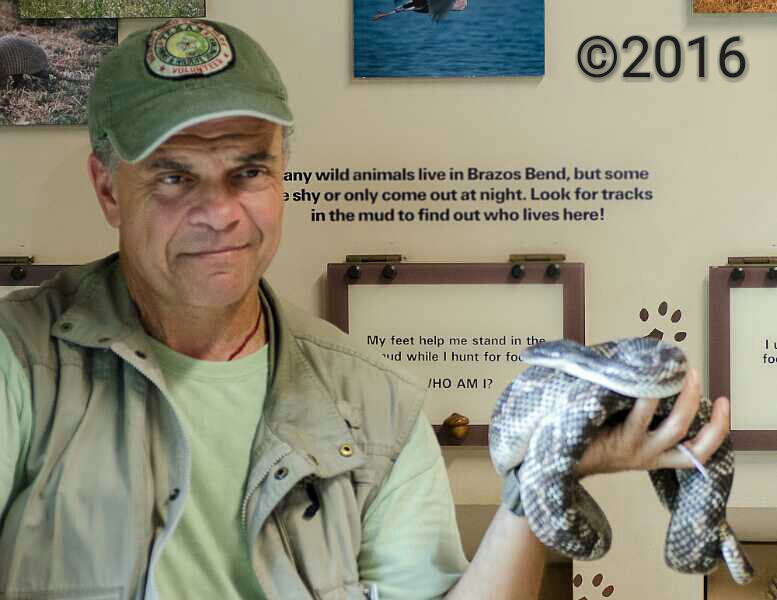
That's me in the Nature Center at Brazos Bend State Park in 2016. I'm holding a Texas Rat Snake that we have there for show. I've gotten enough images of Rat
snakes to collect them here.
Snakes page 2 nonvenomous 2003 -2004 Snakes page 1 nonvenomous 2001 -2002
Snakes page 3 nonvenomous 2003 -2004 Snakes page 7 venomous 2002 -2021
Snakes page 4 nonvenomous 2006 -2021
Snakes page 5 nonvenomous 2022 -2023
----------------------------------
That's
me in the Nature Center at Brazos Bend State Park in 2016. I'm holding
a Texas Rat Snake that we have there for show. I've gotten
enough
images of Rat
snakes to collect them here.
In "Texas Snakes-Identification, Distribution, and Natural History", by John E.
Werler and James R. Dixon (3rd printing 2002) I have the following basic information
about Texas Rat Snakes:
Texas Rat Snake ,Elaphe obsoleta lindheimeri
is one of the longest snakes species found in Texas. Most adults
grow to be 42 - 72 inches long. Colors can vary, but adult
snakes'
marking patterns usually have a median row of large dark blotches
displayed against a lighter background color (usually yellowish or
grayish). Then below them are
are series of alternating blotches.
Scales on the face are white on the lips, across the lower
jaw, and on the throat. The belly is marked with darker squarish
blotches, and the
underside of the tail is usually gray. Most of the
scales are smooth, but scales near the spine are keeled. From
descriptions in the book, Texas Rat Snakes prefer warm-blooded
prey.
They will hunt mammals and birds; and will also eat bird eggs.
Sometimes Texas Rat Snakes are called "Chicken Snakes". Texas Rat
Snakes are very good climbers.
These snakes have a somewhat different
body shape than other snakes. Most snakes are round in cross-section,
with the belly scales making a relatively small flat area. Rat
Snakes
have a much wider belly profile, and the cross section resembles the
shape of "a loaf of bread". This wider belly area may enhance the Rat
Snakes' ability to climb.
(More comments about climbing will appear below.) Over
the 15 or so years that I've been volunteering at Brazos Bend State
Park (BBSP), I've encountered Texas Rat Snakes
out on the trails. I've
decided to collect the various images and video clips I've taken of
them on a single page. The oldest material will be on the bottom.
(Note added May 26, 2021; In 2002 elaphe obsoleta was reclassified as pantherophis obsoletus due to genetic studies. Details can be seen in this paper:
"Molecular
Systematic and Phylogeny of Old and New World Rat snakes, Elaphe
Auct., and Related Genera (Reptilia, Squamata, Colubridae)"
by: Urs Utiger, Notker Helfenberger, Beat Schätti, Catherine Schmidt, Markus Ruf, and Vincent Ziswiler
Russian Journal of Herpetology Vol. 9, No.2, 2002, pp. 105 - 124
(Note added 7/7/2017)
In the study "Gripping during climbing of arboreal snakes may be safe
but not economical" (Greg Byrnes and Bruce C. Jayne Biology Letters
2014 10,
20140434, published 20 August 2014) The
physical force exerted by 5 different species of snakes was measured as
they climbed a vertical pole that was equipped with pressure
sensors
and covered with textured grip tape to roughen the surface. All
of the snakes climbed this surface using a "concertina" motion--that is
they climbed by coiling and
extending their bodies in sections. One
section or loop would grip, allowing another section to extend up; or
to pull up. Results showed that all of the snakes could grip the pole
with
enough force to support 3 times their body weight on that surface.
But they didn't use that much force all of the time, all of them did it
occasionally. It's
reasonable to assume the
Texas Rat Snakes can also exert these forces.
The August 17, 2014 video clip of the snake climbing down the bird box
post shows this coiling and gripping as it moves down the post..
05/09/2021 (posted 5/26/21) I'd
been on the trails at Brazos Bend SP for a while. I was walking
West at 40-Acre Lake with a family that was visiting from out-of-state.
We'd
just gotten past the Observation Tower when we saw this
Rat Snake on the tree! I tried to keep folks back so we could see
what the snake would do. Sometimes they move across
the
trail. I started taking pictures as quickly as I could. The snake never
stopped moving, and in less than a minute it had gone into the grass
and never appeared again. These pictures
came out pretty
good! Notice how the snake's head moved closer to the ground
between each picture. I think the colors on this one are
beautiful, and seem a bit different than what
I usually see on a
Rat Snake. I've gotten a number of pictures and video clips
of Texas Rat Snakes over the years, and they are on this page if anyone would like to compare. Here's
another example of the Texas Rat Snake's climbing ability, as it stayed fastened to the tree as it climbed down. How could it do that?
I've
found many studies that try to define how arboreal snakes climb. One
that describes many of the techniques used by snakes is this one:
"Friction
enhancement in concertina locomotion of snakes" by Hamidreza Marvi and
David L. Hu in J. R. Soc. Interface doi:10.1098/rsif.2012.0132
I
think I can see this snake demonstrating some of the effects mentioned
in the study. A Rat Snake's shape--flat on the bottom--allows for
more contact along the bottom, while
the "corner" at the edge of
belly and side is also a gripping tool. Climbing snakes can
control the angle of each belly scale to allow for better grip.
(Imagine a standard horizontal
Venetian blind on a
window. Then imagine controlling the angle of each slat by itself.) A
climbing snake will also use irregularities, branches, etc. as contact
and support points to push
on with individual curves while climbing.
Another trick is pushing on the climbing surface to make small
"bridges", which cause grip to be concentrated on single controlled
points instead
of over the entire body. Snakes general shape
allows it to distribute its body so that there is no single point where
its center of gravity is greater--it doesn't lose balance because a
single
heavy part won't pull it away from the tree. These techniques work whether the snake is climbing or descending.
August 17,
2014 (posted 6/29/17); I
noticed this Rat Snake in one of the bird boxes in 40 Acre Lake. This
is the same bird box that had a serpent "guest" on May 14th. I filmed
video as the snake left the box. These images are frame grabs from the video. The video can be seen here (mp4). The snake moved up to the back of the box.
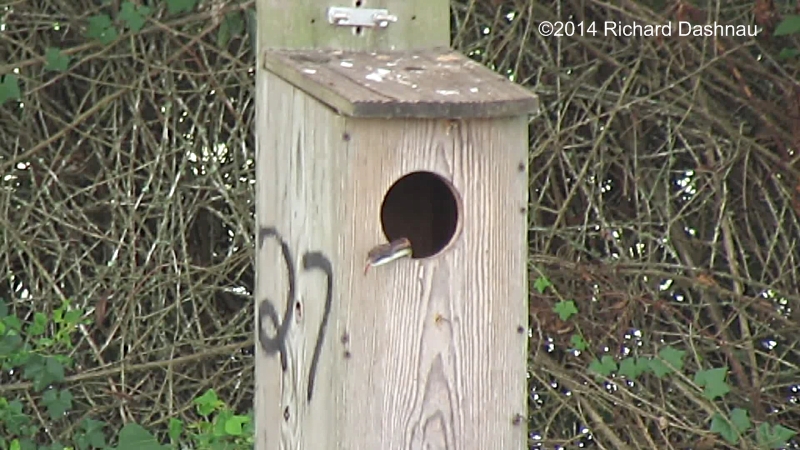
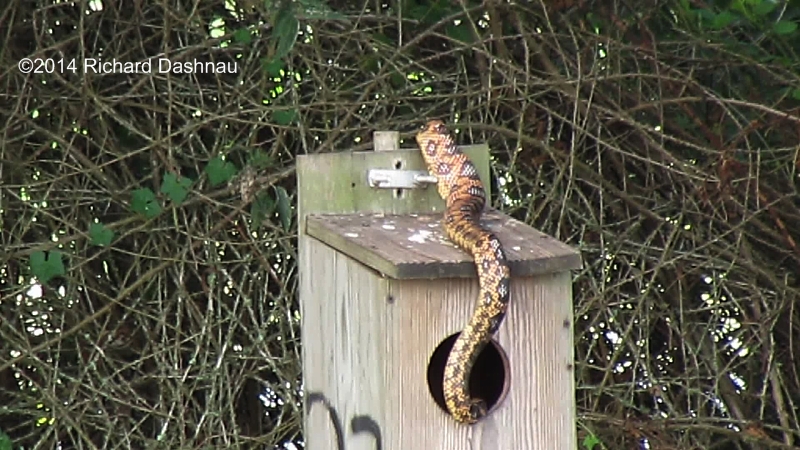
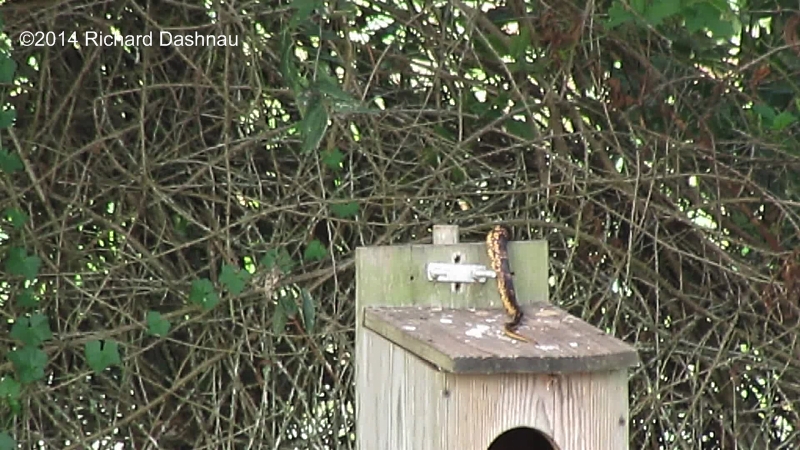
Then
the snake moved down the rear of the box--probably following the
support pipe. I noticed a large lump in the snake (last picture
below right)
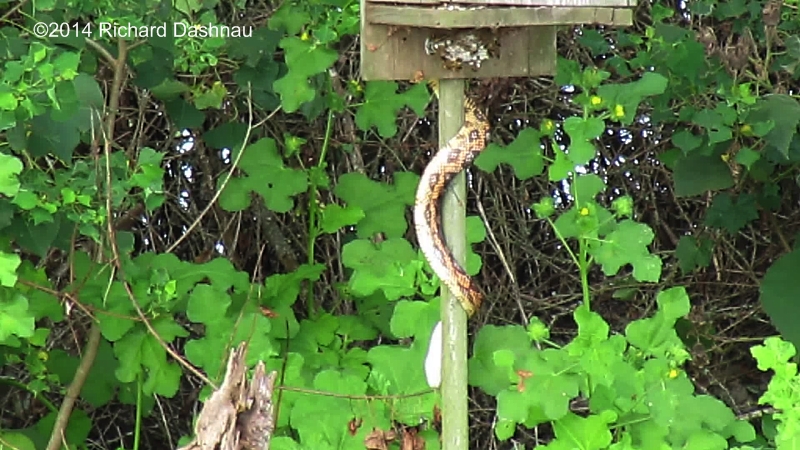
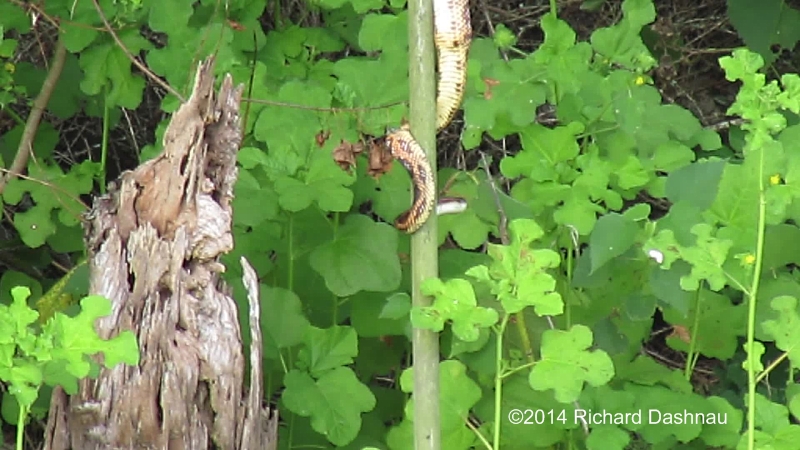
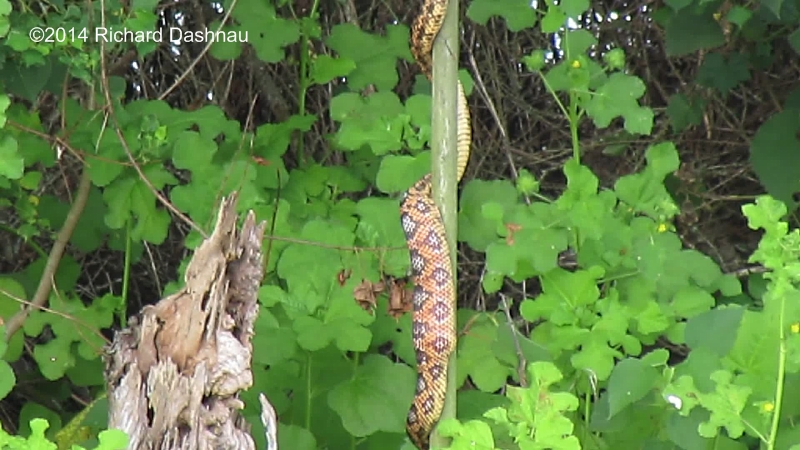
This
was an impressive snake. Look at the size compared with the support
pipe and the bird box. The snake was able to support its
weight(without sliding down the pole) while it
reached over to the stump. The snake bridged the gap (cantilevered) to the nearby stump, and moved off into cover.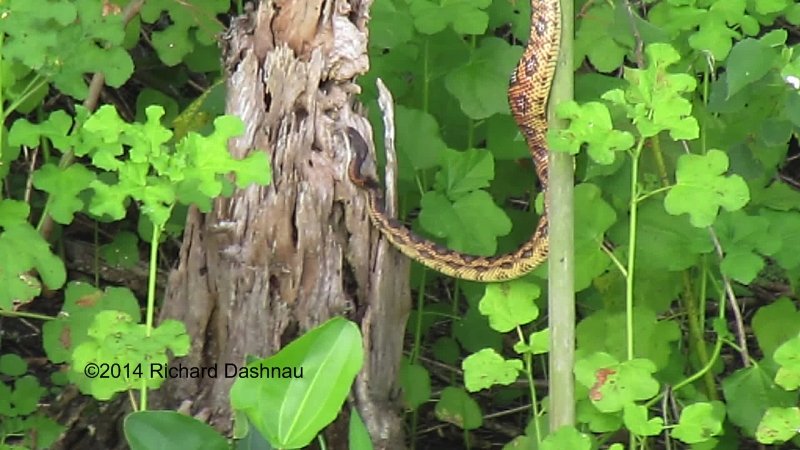
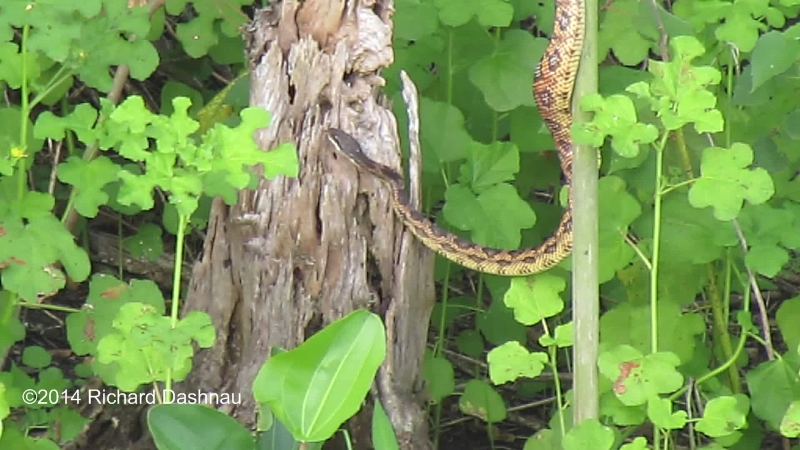
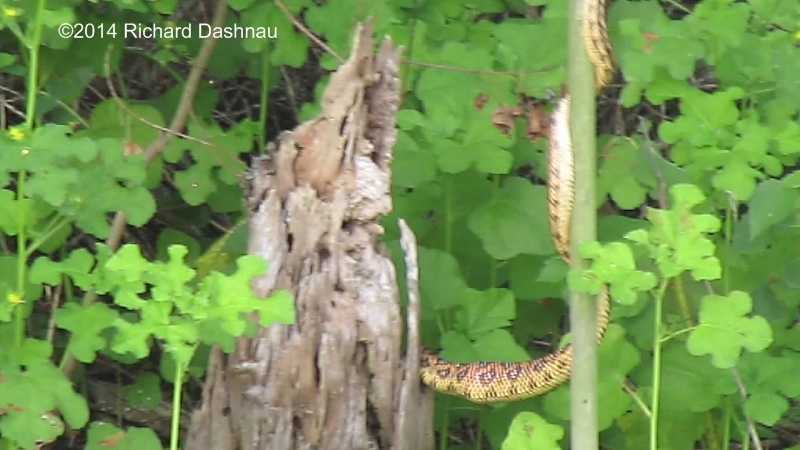
May 11,
2014; There are a number of "bird boxes"
in various places throughout Brazos Bend State Park. They were
installed as nesting boxes for birds--especially ducks. Black-bellied
Whistling Ducks like to use them. And sometimes snakes will use
them...or raid them. I noticed something going on in this bird
box in 40 Acre Lake. As this Texas Rat Snake climbed out
of the
bird box, it demonstrated many aspects of its climbing
ability. First I took some photos of the snake in the box, and when I
realized what it was doing, I filmed some video. 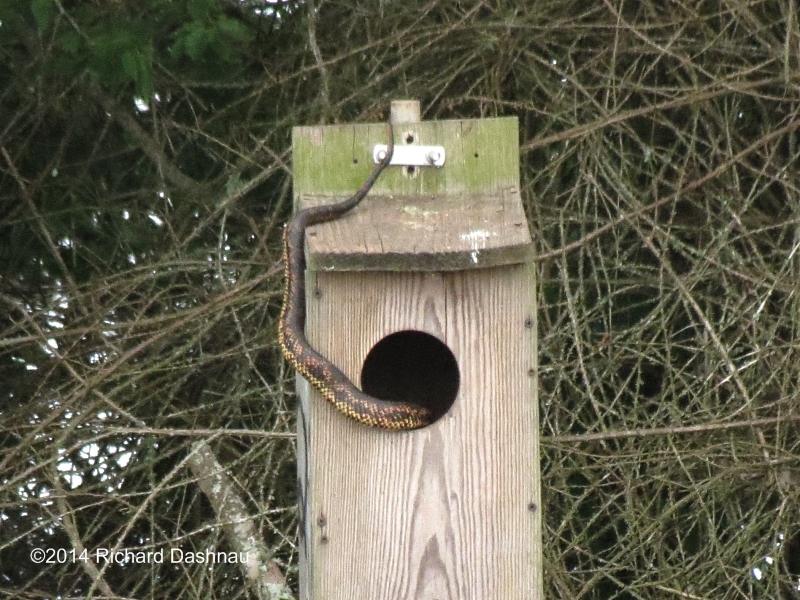
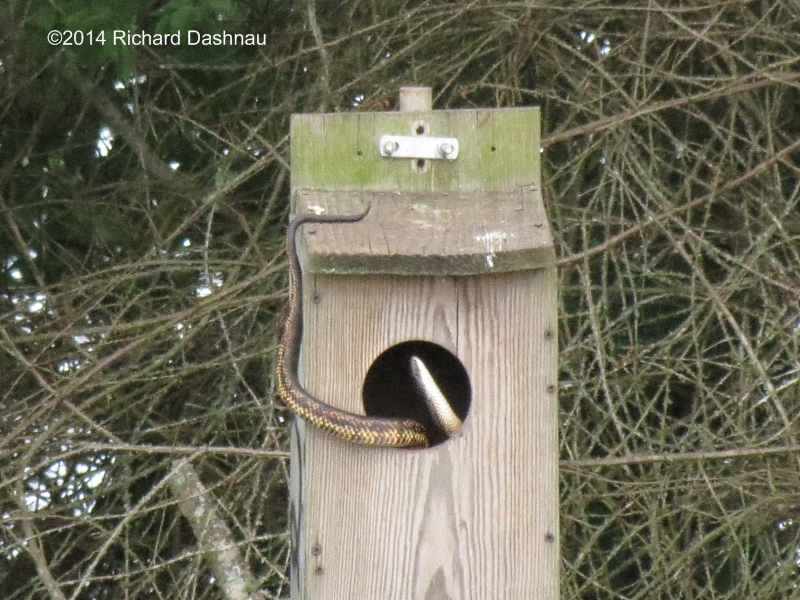
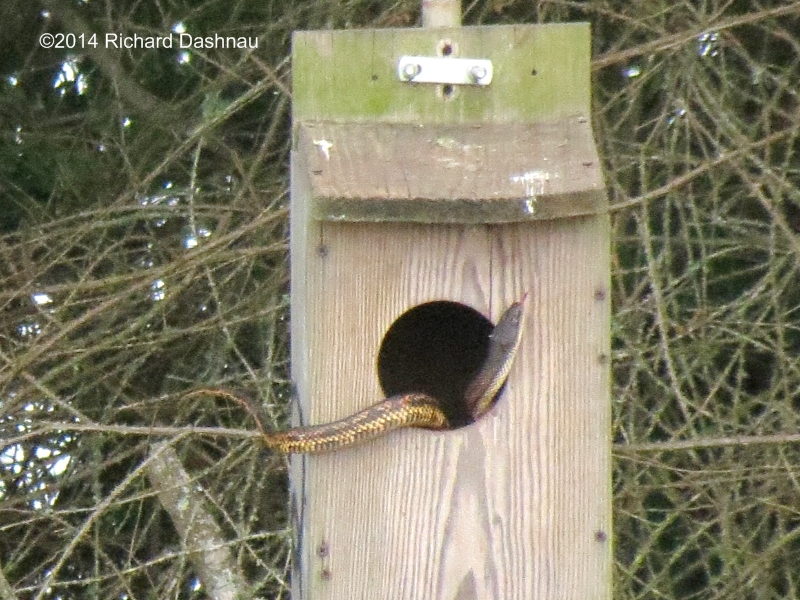
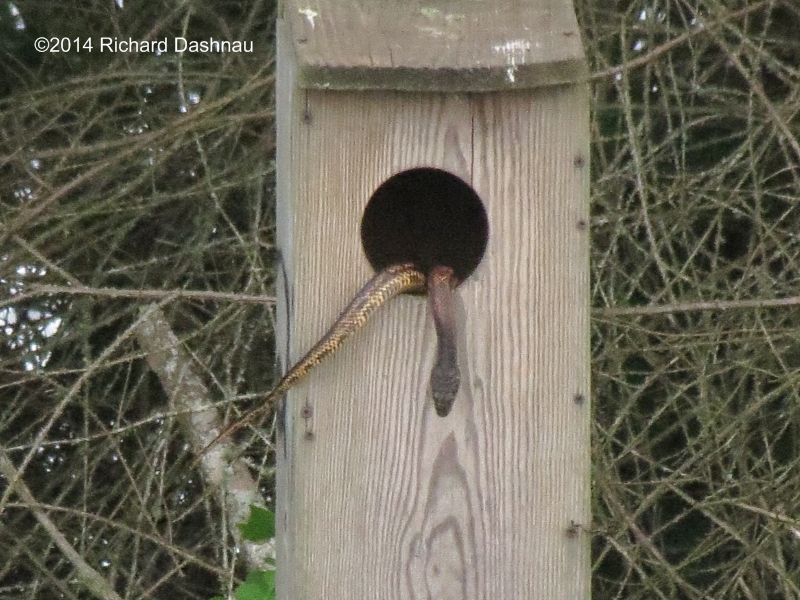
The images below are frame grabs from the video clips. . I have edited the video clips into a film that shows from this link (mp4).
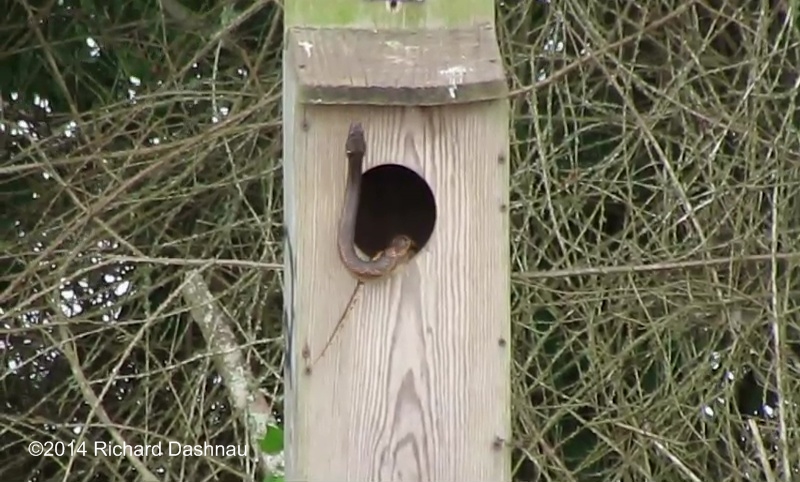
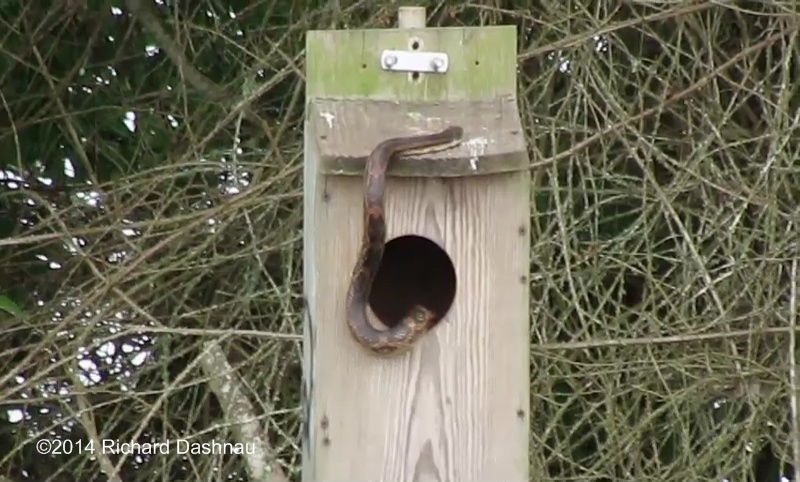
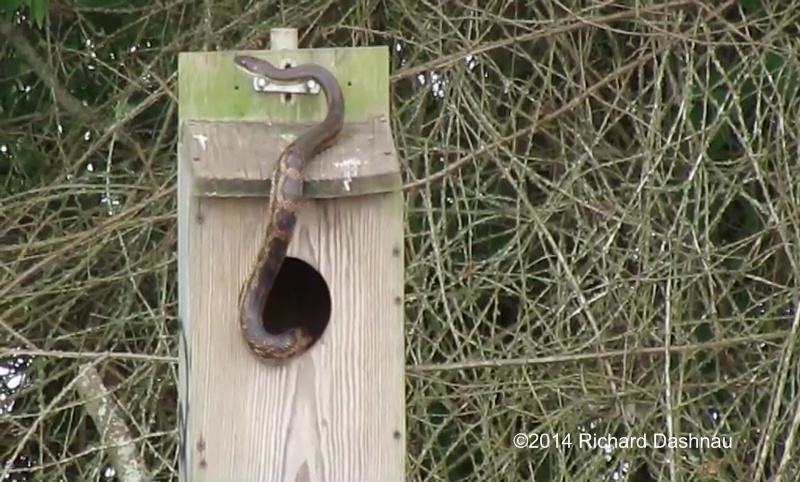
December 02,
2012; I
was on the Spillway Trail when I noticed a Texas Rat Snake moving
moving up in a tree. I stopped to watch the snake. The Rat
Snake seemed to be resting, lying on
a sun-warmed branch, and
hidden by the Spanish Moss around it. It started moving, and I
watched as the 5 or 6 foot snake moved effortlessly over branches that
were thinner than the snake.
It finally moved up into enough cover to prevent me from further filming.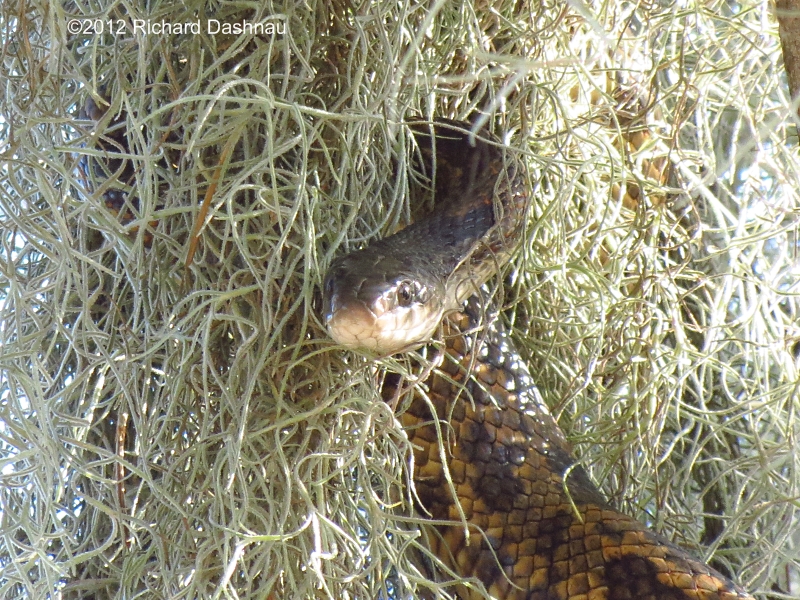
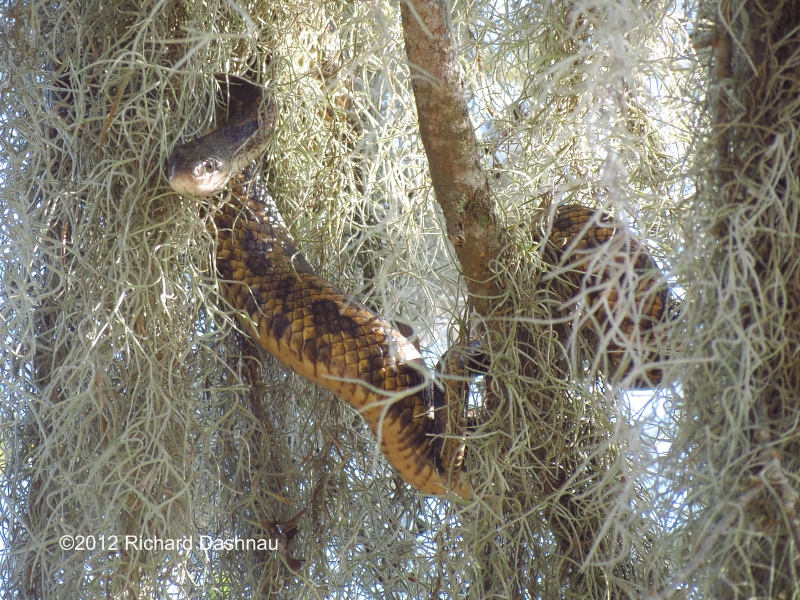
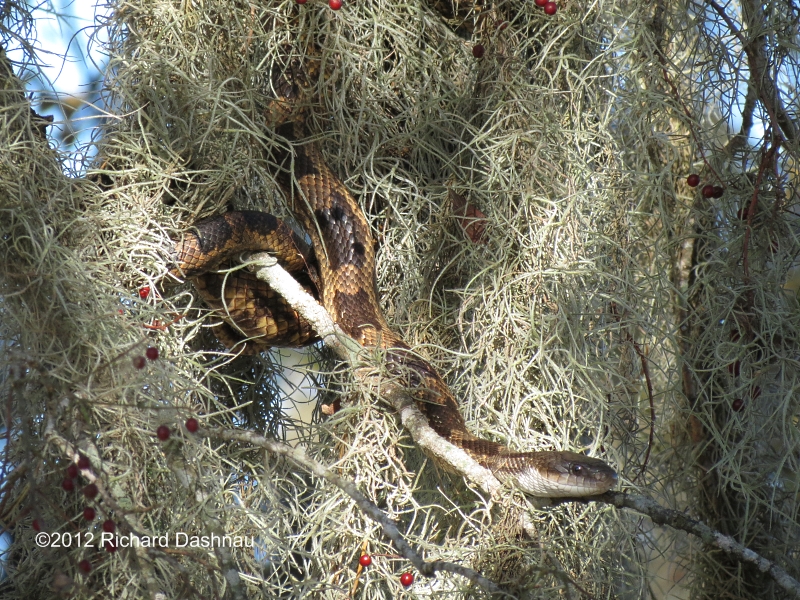
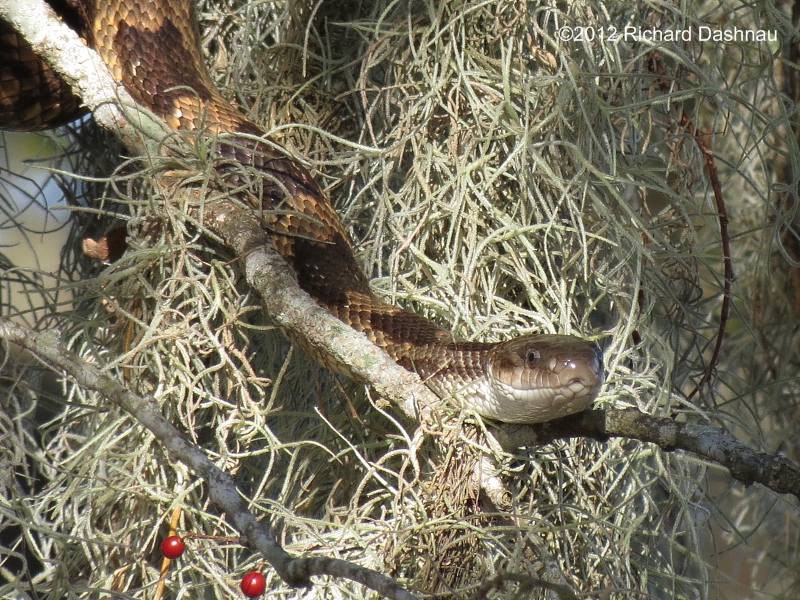
The
sun brought out the colors of this beautiful snake, and the pattern of
large spots was clearly visible. I have edited some short video clips
that I filmed into a film that shows from this link (mp4).
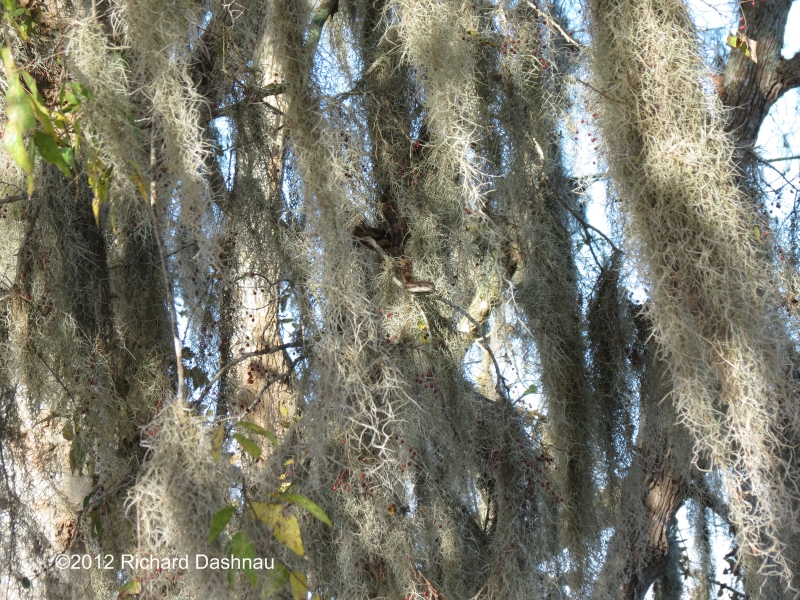
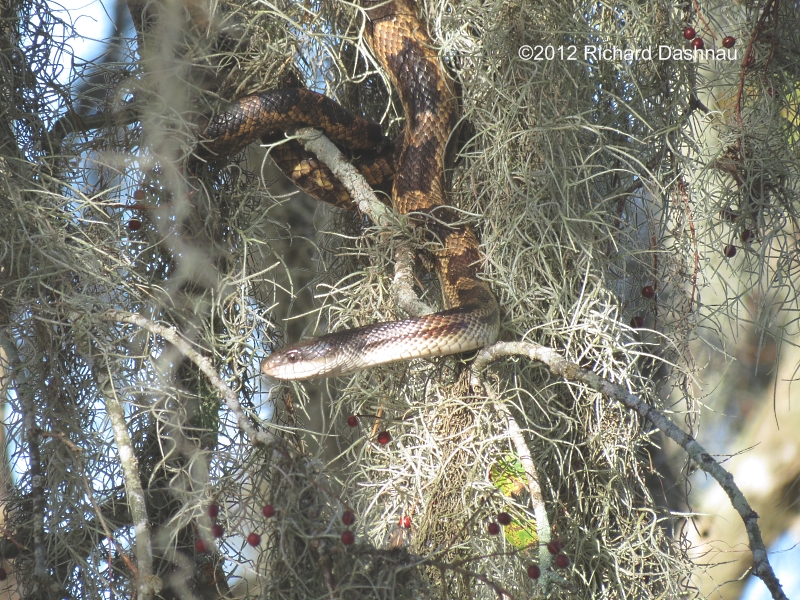
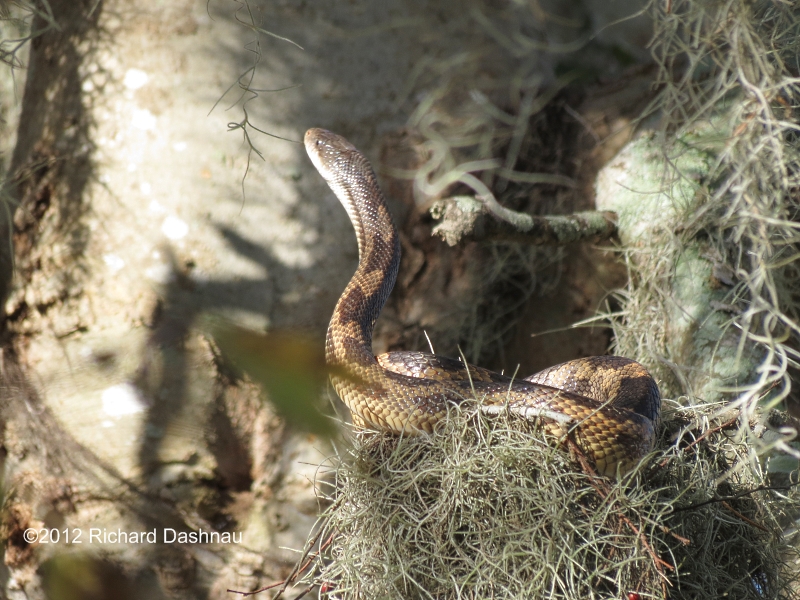
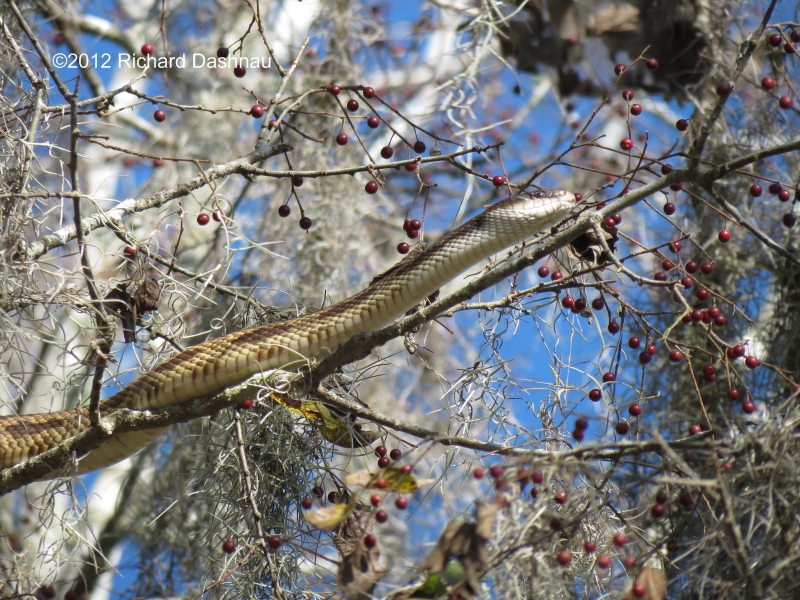
October 21,
2012; I
was on the Spillway Trail when I noticed a Texas Rat Snake moving
parallel to the trail. I stopped to watch the snake. The Rat
Snake seemed to be following a trail, since
it
was continuously
extending its tongue. it was feeling the air with its tongue, but it
was also touching the bark and various other objects in its path.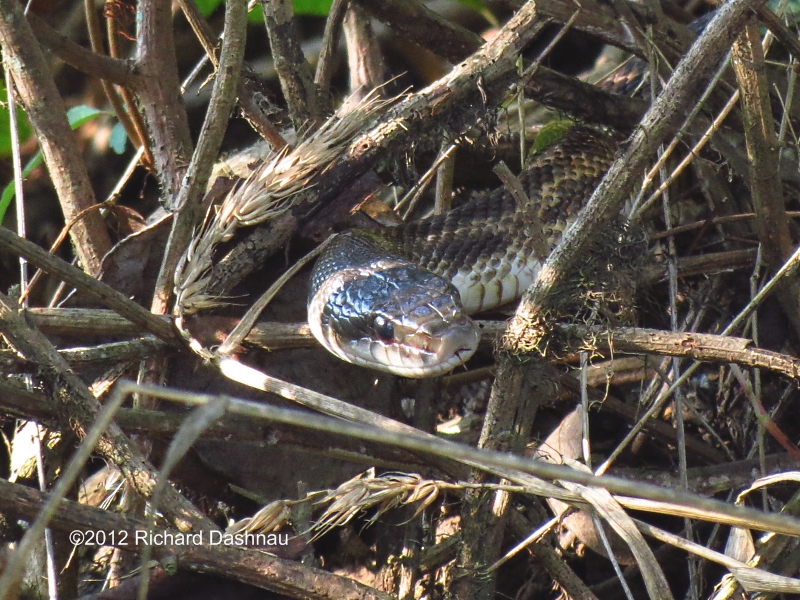
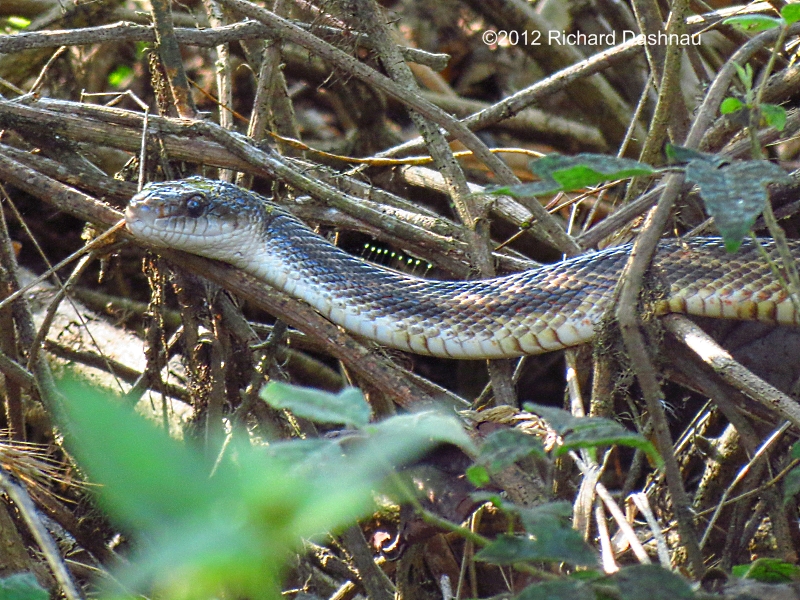
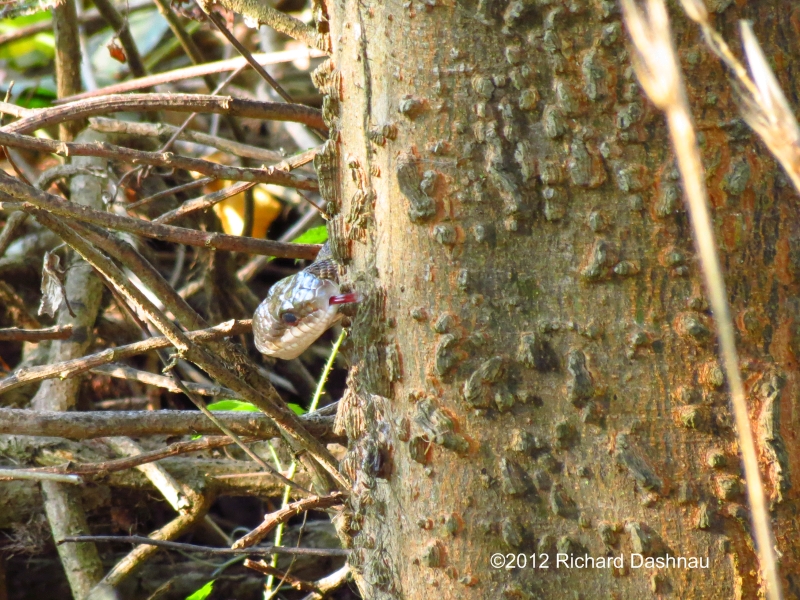
The
invisible trail seemed to lead up the bark of a nearby tree. The snake
didn't get very far before it turned around and moved back down onto
the ground. Then the
snake resumed its movement through the
leave. Occasionally, a snake will open its mouth, in a slow, wide gape.
The last picture below shows the lucky shot I got when this
rat snake decided to open its jaws and stretch. This is ONLY a wide gape (or a yawn). The snake was not striking at anything.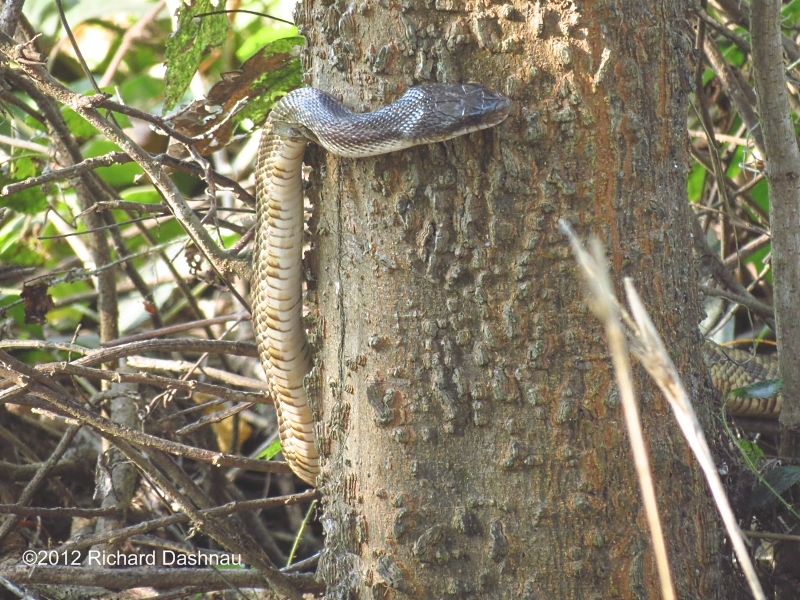
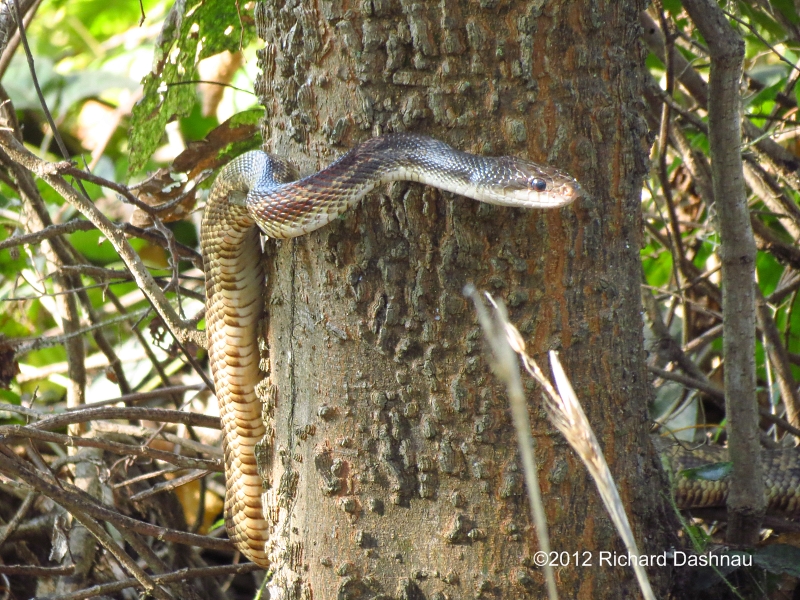
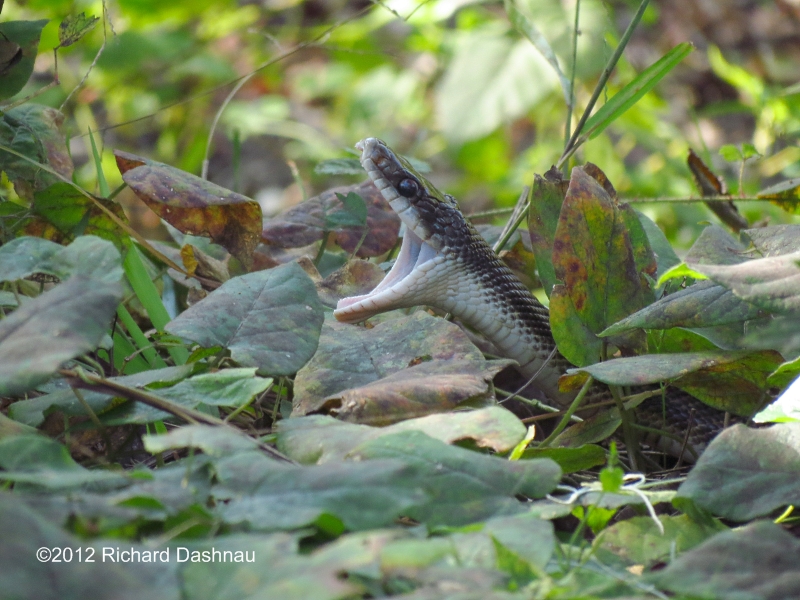
April 15,
2012; It
was about 9:30am and I
was walking down the Spillway Trail just West of the Spillway
Bridge when I noticed something odd in one of the "duck nesting" boxes, about 20
yards away from me.
Something was in the entry hole. It sure didn't look like a duck's
head...or anything I could easily recognize. A look through the
binoculars solved the mystery. It was a
Texas Rat Snake (Elaphe obsoleta lindheimeri) relaxing in the
opening! It looked as if it was enjoying the morning, and watching the
world go by. The snake didn't move while I watched,
and I finally left. This seems to be an example of a Rat Snake using a bird
box for a shelter (instead of going in to hunt for young birds or
eggs), but it could have entered to box originally
for that purpose.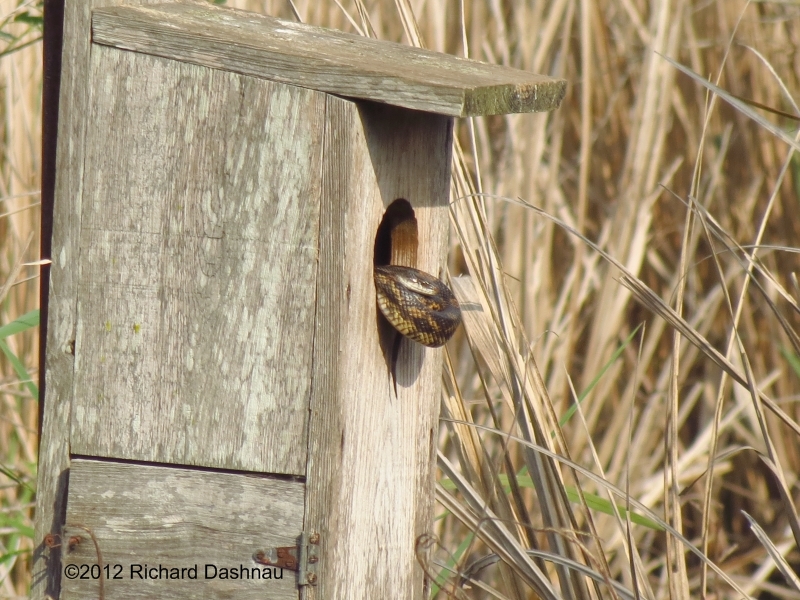 -
-
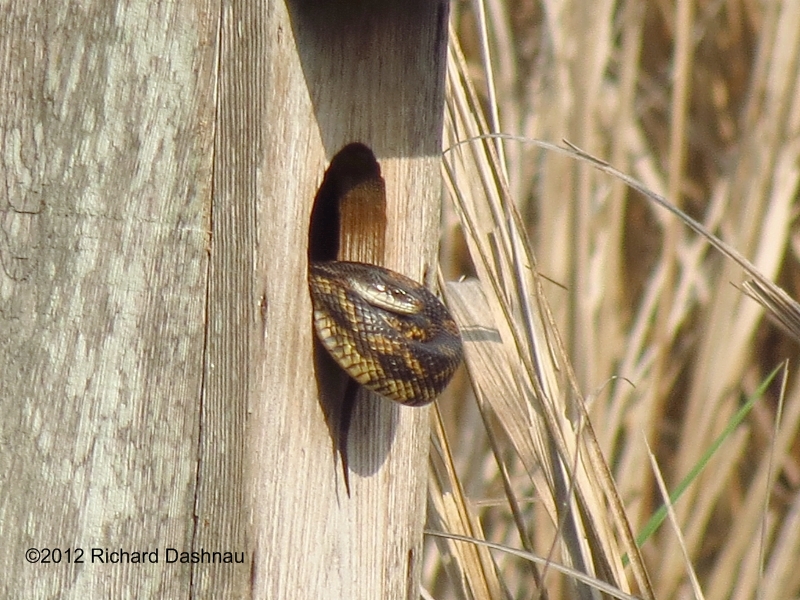
April 01,
2012; I was on the Spillway Trail when I noticed a Texas Rat Snake moving parallel to the trail. It slowly moved closer to the trail, and then finally crossed it. I lost it among the leaves.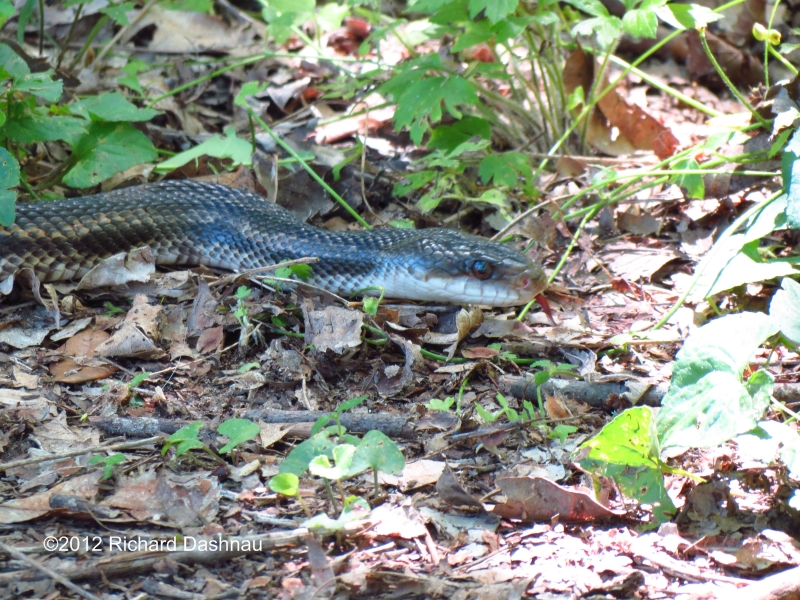 -
-
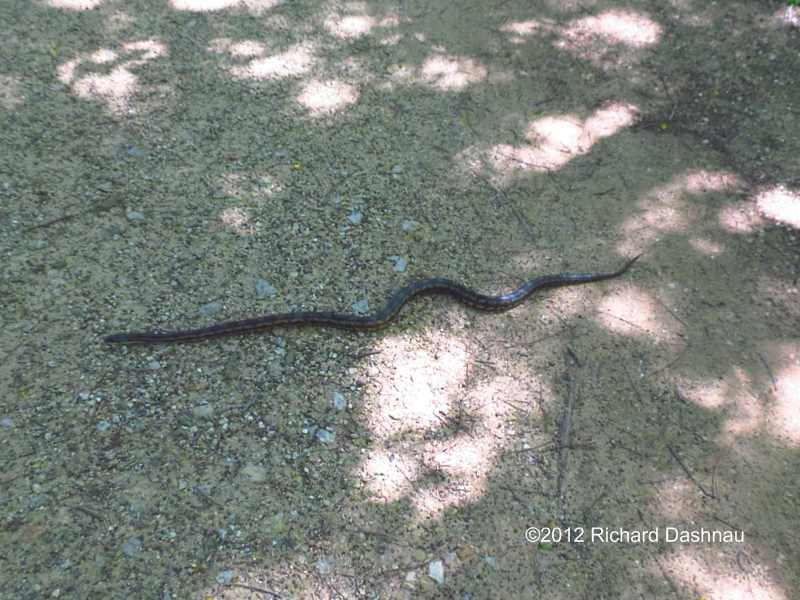
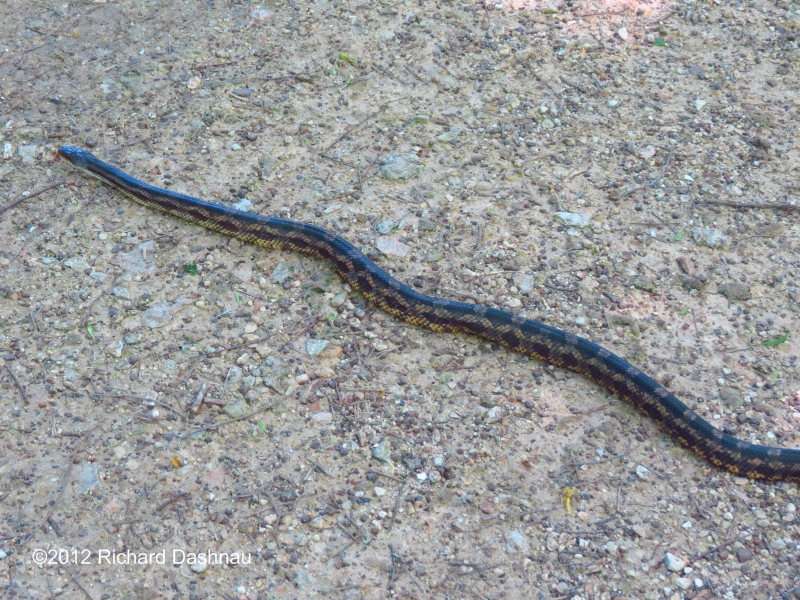
May 02,
2010; At about 1:15 PM, I was walking on the East side of the 40 Acre lake trail when I noticed this Texas Rat Snake (Elaphe obsoleta lindheimeri) relaxing in a tree next to trail. It
was about 12 feet above the ground. I took a few pictures of it, then left it to enjoy the day.
January 04,
2009; This
Texas Rat Snake moved near a trail. From the way that it appeared to be
sensing along it's path, I thought it was tracking something. The last
two images
are frame grabs from a short video clip I shot before I had to move on. The two images show the start of a "cantilever maneuver"-where the snake bridges a gap with its body.
The video clip can be seen here.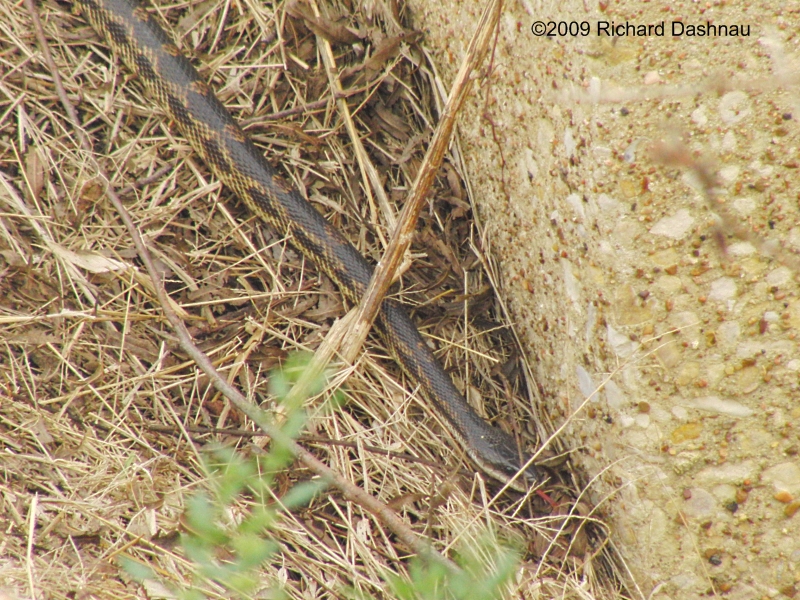 -
-
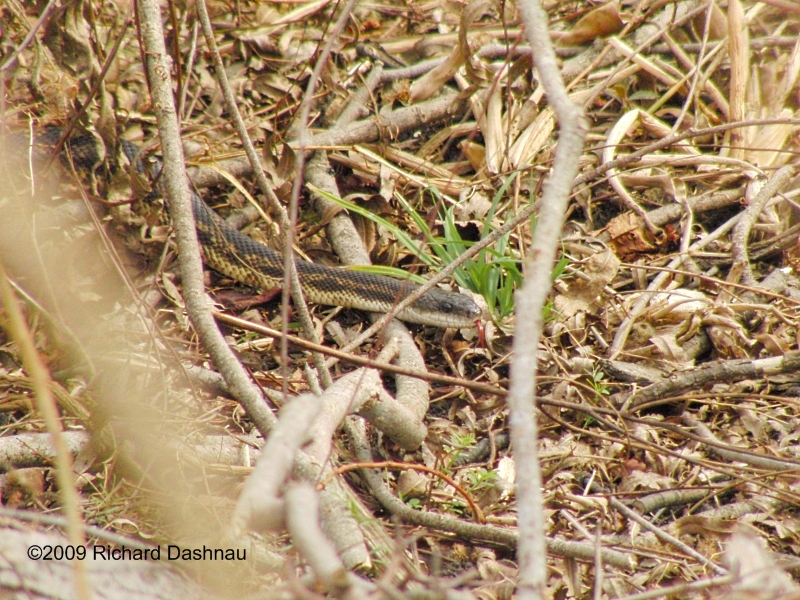
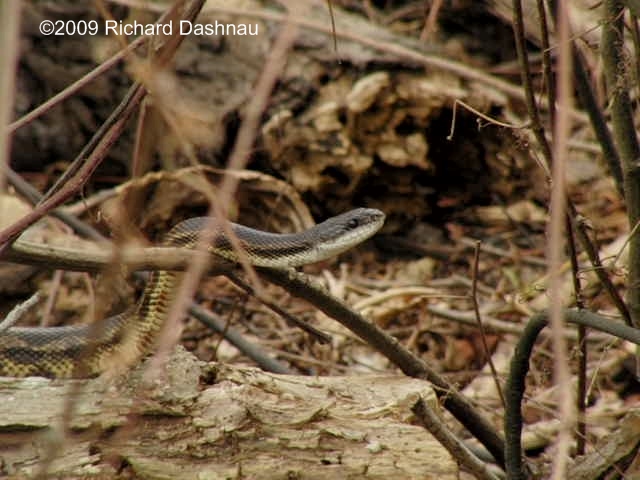
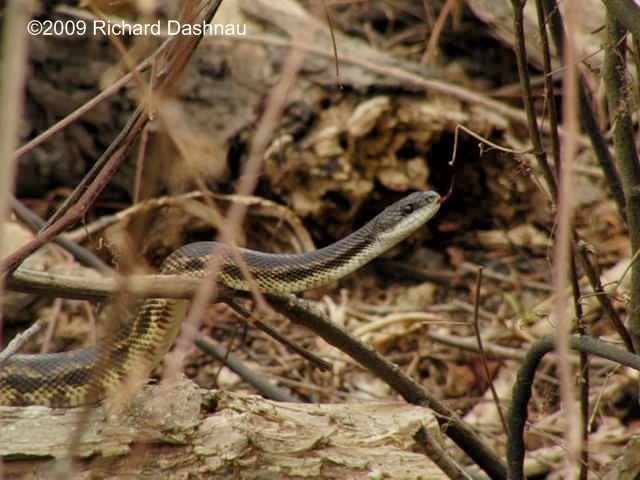
May 13,
2007; I
got a quick shot of this Texas Rat Snake as it crossed the trail. It
shows the coloration and patterns that make it easy to identify.
---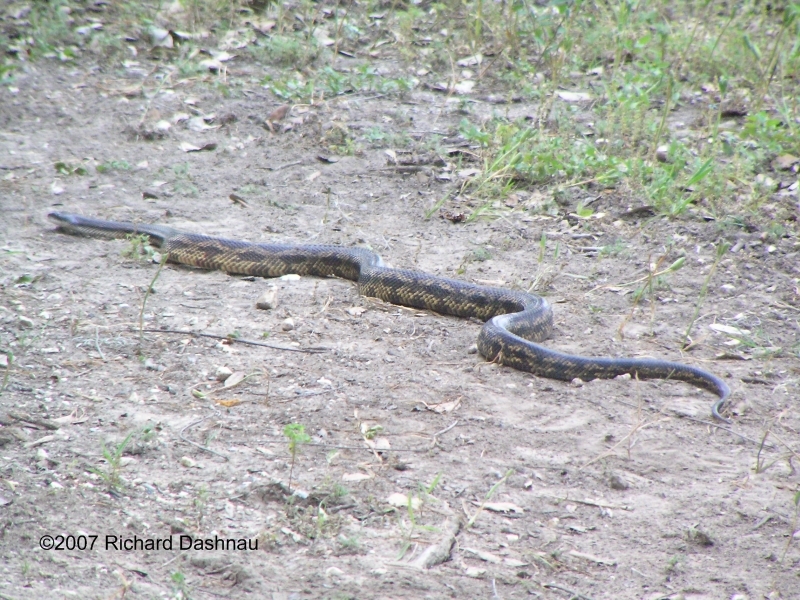 ---
---
MOVING ALONG THE TRAIL
May 15,
2004; I saw some park visitors closely watching
one of the bird boxes (see BIRD BOX AND VISITOR, below). When I looked,
I saw what looks like a long Texas Rat Snake coming out
of the box. By
the time I could get to a clear vantage point, it had almost gotten to
the bottom. I was able to get just the one picture. (ON THE POST, and LONG
SNAKE are both cropped versions
of the same image as the first one.)
Texas Rat Snakes are excellent climbers, and can turn up, evidently, almost
anywhere.
--- --
--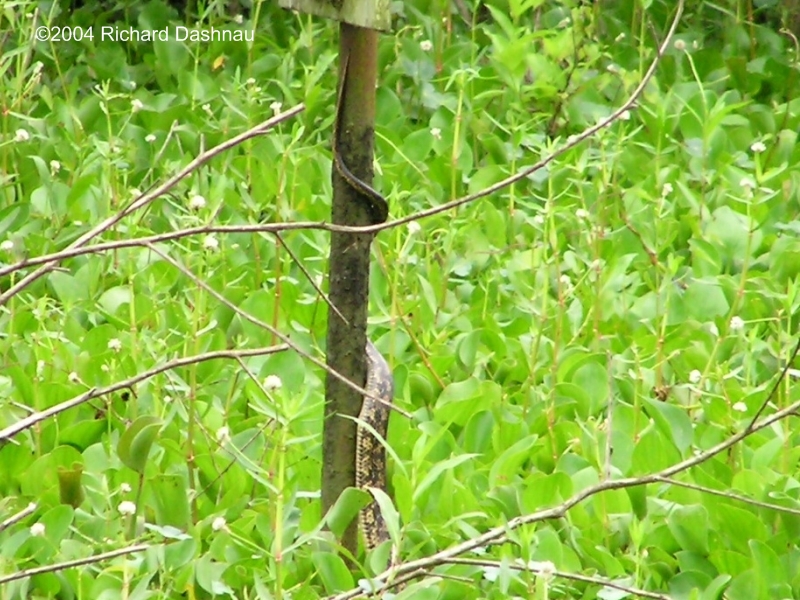 -
-
WHAT'S THAT ON THE
POST?
LONG SNAKE TAIL
March
14, 2004
Now, here is another example which shows that you can always be surprised
at what you'll see at Brazos Bend State Park. I was near the owls
when I noticed a group of children
and a teacher further away. I walked
over to them and offered to show them some owls, and also to escort them
past an alligator nearby on the shore of the lake. While we were looking
at the owls,
the teacher (day care person) pointed at one of the large
hollows way up in the tree, and said she saw another owl in there. I looked,
and didn't see anything. When I examined the hole through
binoculars, I
didn't see any owl. I DID see, something interesting, though. A large snake
(probably a Texas Rat Snake) was already halfway into the hole, and as
I watched, the rest of it slowly slid in.
After
the group left, I took another look up at the hole, and here is what I
saw.
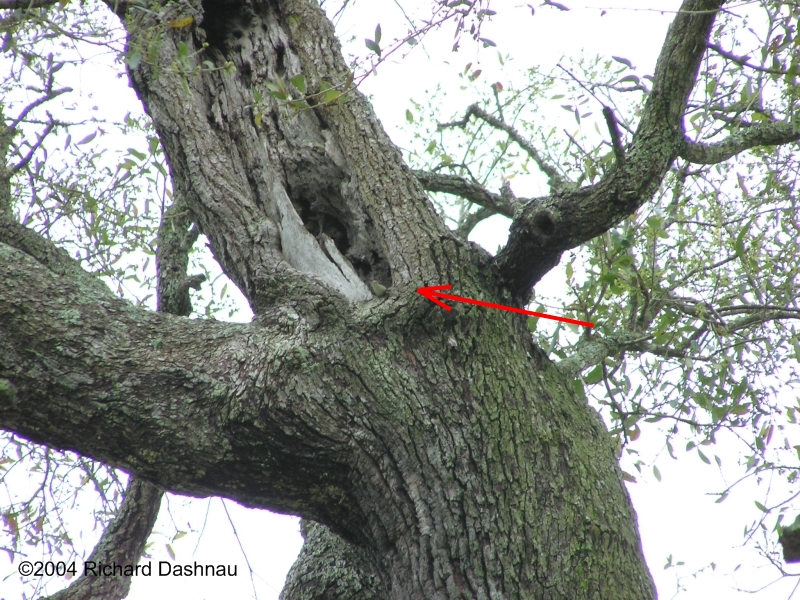 -
-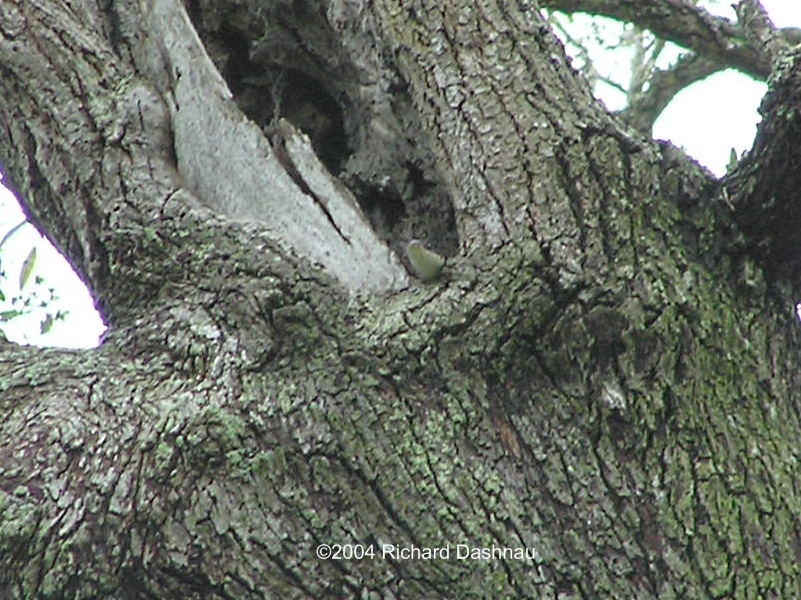 -
-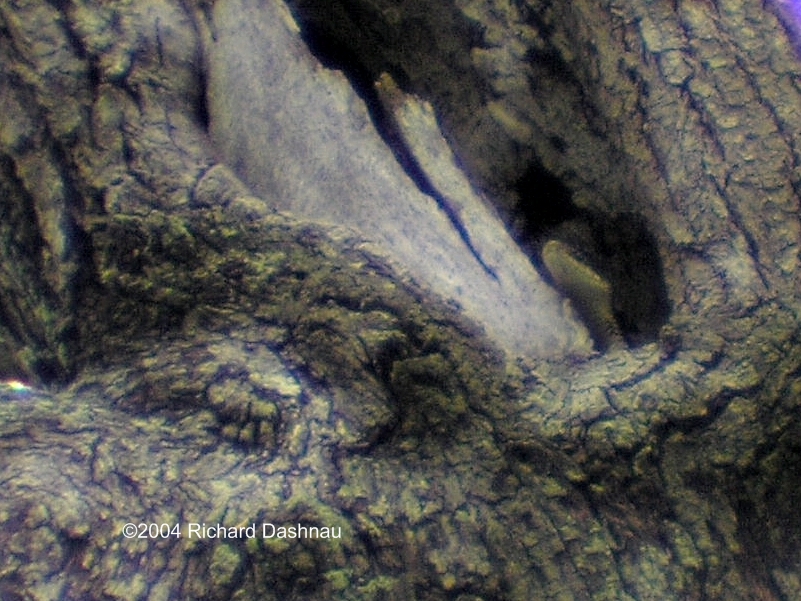
UP IN THE TREE
PEEKING
OUT
PEEKING OUT
CLOSEUP
-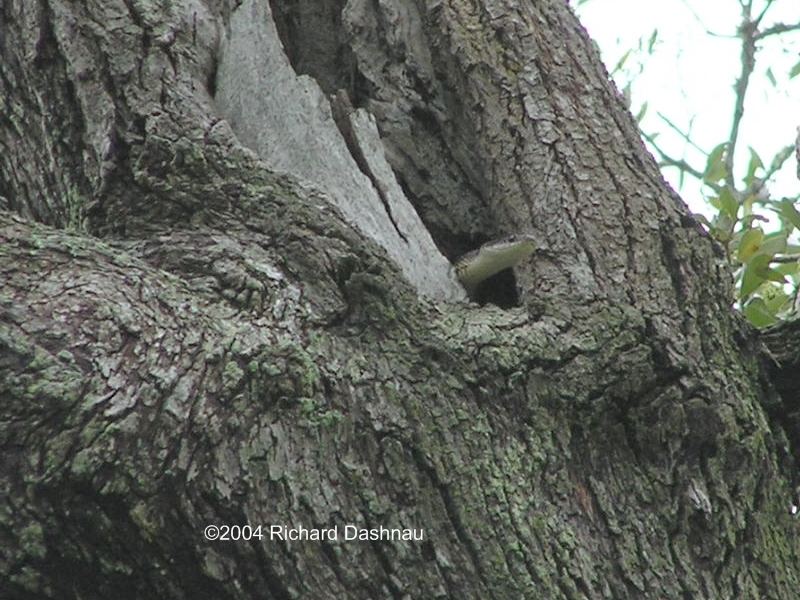 -
-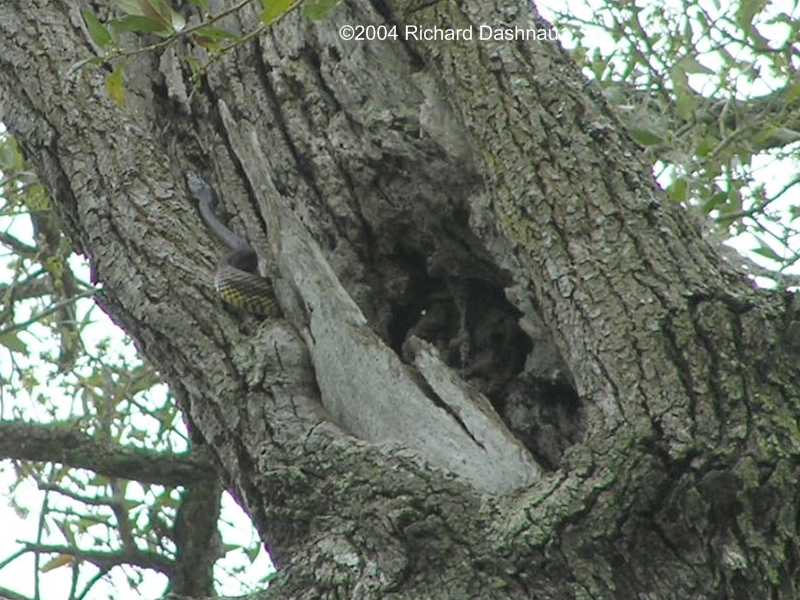
WHERE ARE THE OWLS?
STARTING TO CLIMB
Peeking
out from the darkness of the hole, the Texas Rat Snake (I'll be surprised
if it *isn't* one) seemed a bit perplexed (see PEEKING OUT, and CLOSEUP,
above). As I watched (By the way,
this all took about 45 minutes.
A nice, relaxing way to spend some time.), I would walk over to see if
the owls moved (so I could get a picture), then I'd come back and check
on the snake. The snake
later looked off to the side (see WHERE ARE THE
OWLS, and CLOSER, and EVEN CLOSER, above).
Next,
the snake attempted to climb up to the next hole (see I HEARD THERE WERE
OWLS,
and CLOSER, below). It was probably hunting, and I wonder if it was
looking for the young owls. Their scent was probably in various parts of
the tree. Now, snakes are among the animals that owls eat,
and I
thought about the risk the snake had taken to get all the way up there
in the first place (see, THE SNAKE AND OWL, below). That snake was
*way* up in the tree!
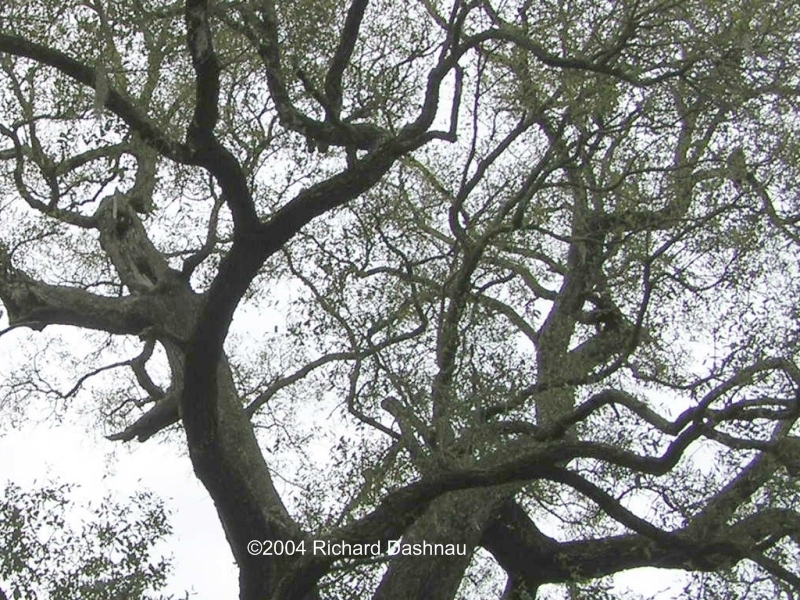 -
-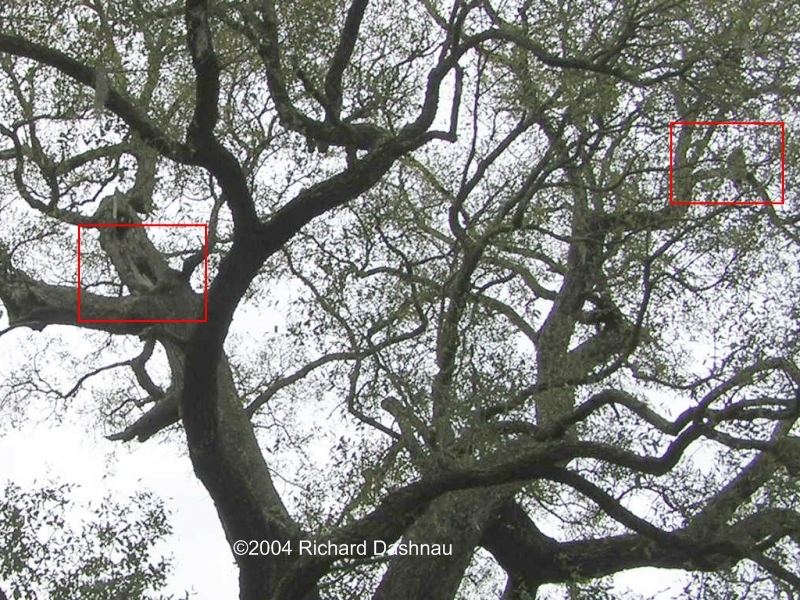 -
-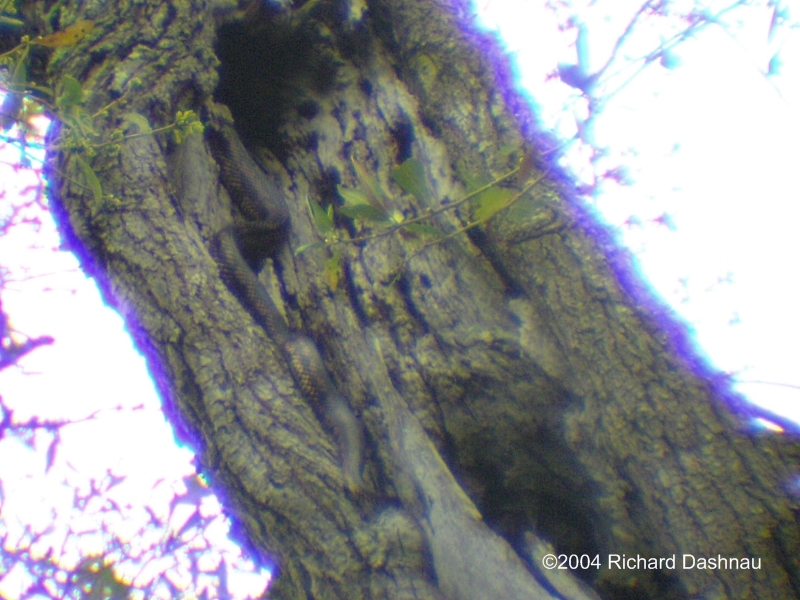
I HEARD
THERE WERE OWLS UP THERE
OWL IN RIGHT SQUARE, SNAKE IN LEFT
THERE IT GOES
-I checked
the owls again, and when I got back, the snake was investigating further. Finally, it climbed up and went into the hole
above it (see THERE IT GOES, above). As always, I enjoyed being able
to
slow down to a reptilian pace for a while. I was also impressed by how
slowly and carefully the snake moved. By moving so slowly and steadily,
it would probably avoid detection by most other animals.
You never
can be sure what's above you in the trees, can you.
--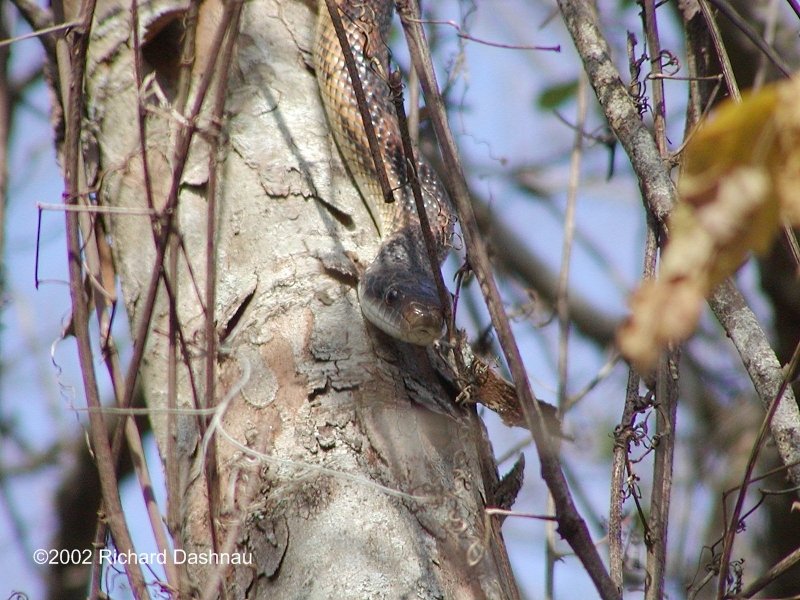 -
-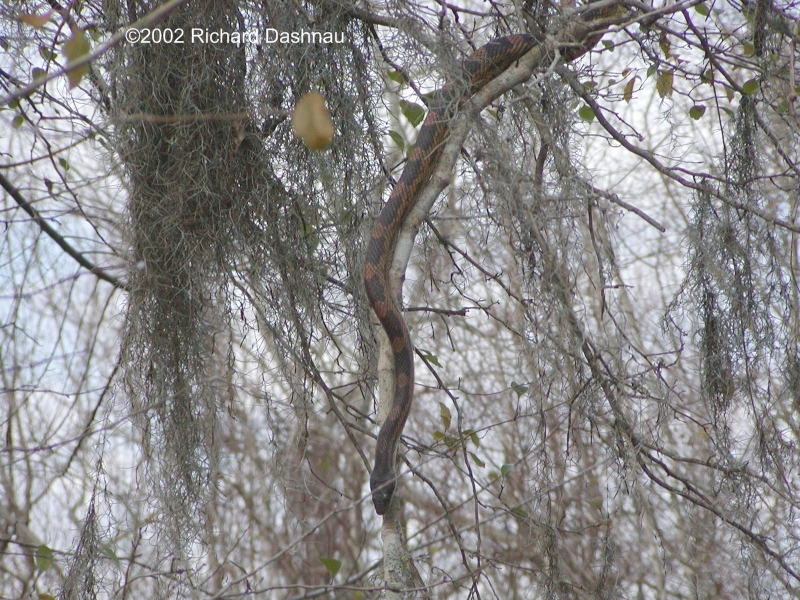 -
-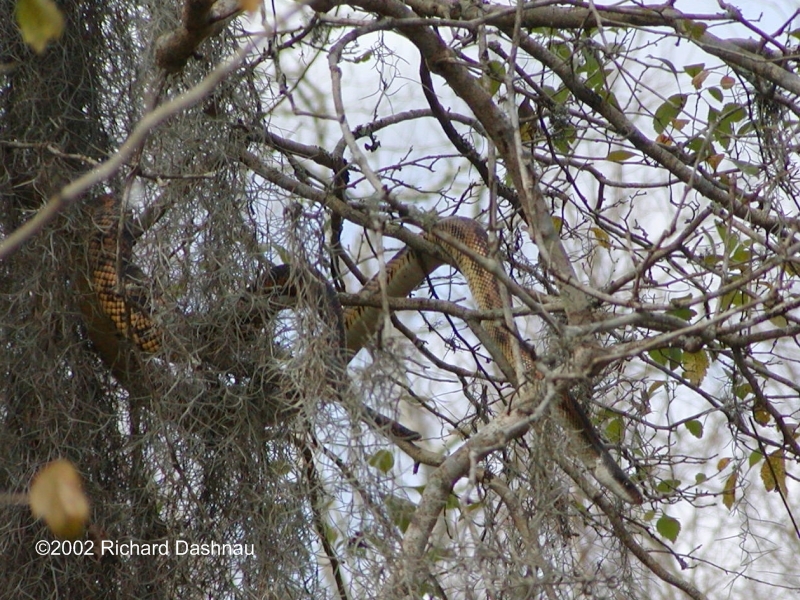
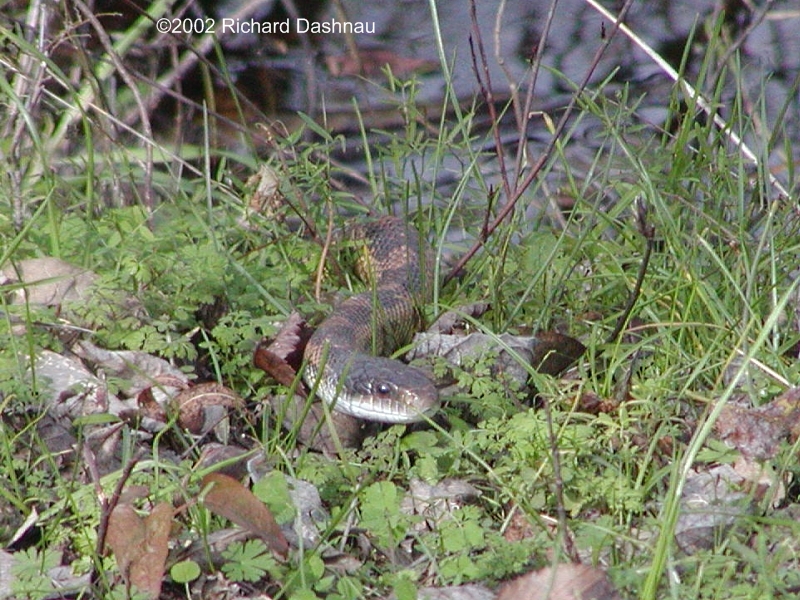
TEXAS RAT CHECKS
TEXAS RAT
CLIMBS TEXAS RAT
CLIMBS 2
MOVING BETWEEN TREES
-
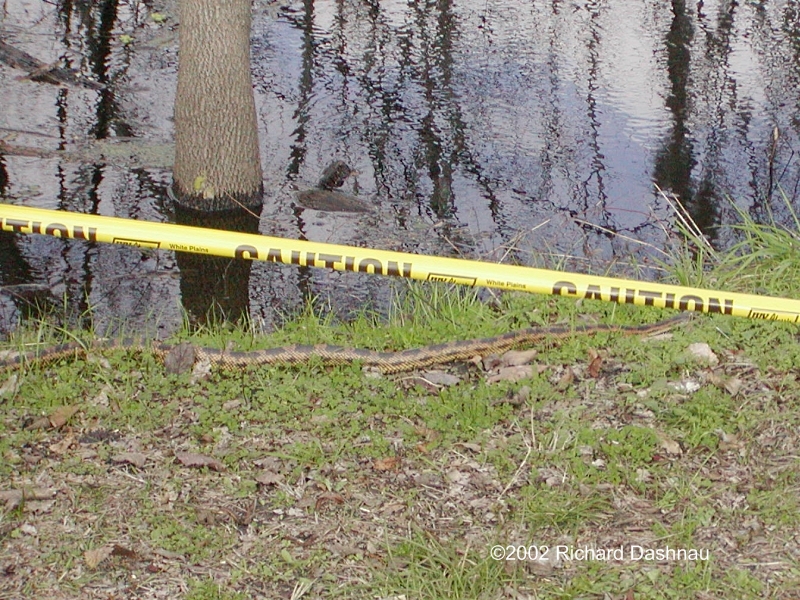
LONG SNAKE, EH?
While
I was chasing anoles and spider eggs, I was told about a large snake in
a tree a little further down the trail. Of course, I went to see it. This
turned out to be a very nice specimen of the Texas
Rat Snake. When I got
there, it was watching a group of people on the trail (TEXAS RAT CHECKS,
above). Then it started moving around (TEXAS RAT CLIMBS, above). This was
a large snake.
Eventually, it made its way across to another tree,
and down to the ground, where it passed by, and went under another tree.
Note the safety tape in the picture. Previous visitors to this site may
recognize it as the tape in the "mother alligator" pictures. It is. This
is almost exactly where I took the pictures of the mother alligator and
babies (Nov. 15).
Snakes page 2 nonvenomous 2003 -2004 Snakes page 1 nonvenomous 2001 -2002
Snakes page 3 nonvenomous 2003 -2004 Snakes page 7 venomous 2002 -2021
Snakes page 4 nonvenomous 2006 -2021
Snakes page 5 nonvenomous 2022 -2023
Go back to my home page, Welcome
to rickubis.com
Go
back to the RICKUBISCAM page.